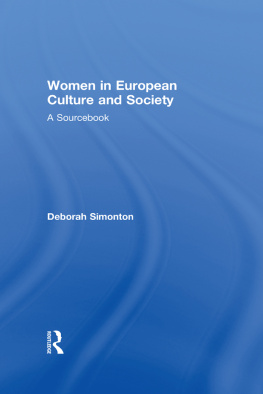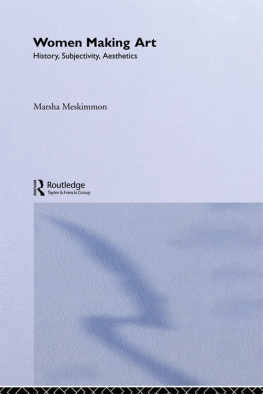Routledge Library Editions: Womens History
Women in Europe Since 1750
First published in 1978
This edition first published in 2013
by Routledge
2 Park Square, Milton Park, Abingdon, Oxon, OX14 4RN
Simultaneously published in the USA and Canada
by Routledge
711 Third Avenue, New York, NY 10017
Routledge is an imprint of the Taylor & Francis Group, an informa business
1978 Patricia Branca
All rights reserved. No part of this book may be reprinted or reproduced or utilised in any form or by any electronic, mechanical, or other means, now known or hereafter invented, including photocopying and recording, or in any information storage or retrieval system, without permission in writing from the publishers.
Trademark notice: Product or corporate names may be trademarks or registered trademarks, and are used only for identification and explanation without intent to infringe.
British Library Cataloguing in Publication Data
A catalogue record for this book is available from the British Library
ISBN: 978-0-415-53409-3 (Set)
eISBN: 978-0-203-10425-5 (Set)
ISBN: 978-0-415-62583-8 (Volume 4)
eISBN: 978-0-203-10312-8 (Volume 4)
Publishers Note
The publisher has gone to great lengths to ensure the quality of this reprint but points out that some imperfections in the original copies may be apparent.
Disclaimer
The publisher has made every effort to trace copyright holders and would welcome correspondence from those they have been unable to trace.
Women in Europe Since 1750
PATRICIA BRANCA
1978 Patricia Branca
Croom Helm Ltd, 2-10 St Johns Road, London SW11
British Library Cataloguing in Publication Data
Branca, Patricia
Women in Europe since 1750.
1. Women Europe, Western Social conditions
I. Title
301.412094 HQ1587
ISBN 0-85664-225-8
ISBN 0-85664-729-2 Pbk
Printed and bound in Great Britain by
Billing & Sons Limited, Guildford, London and Worcester
Contents
Encountering the table of contents of this book, a reader could conjecture that, given the youth of womens history, the undertaking was a mite presumptuous as a field of scholarly endeavour. A moment, then, for my sense of purpose. In eight years of researching and teaching in the field I have continually tried to come to grips with what has seemed to me at times to be the riddle of the sphinx. What is womens history? Each year new works of scholarship are published on diverse aspects of this subject: biographies of eminent women, monographs on suffrage movements, studies of womens economic roles and family position along with polemics on the culture of womanhood. What I wanted to know was how did all these pieces fit? Was there any relationship between the history of the mill girl and the experience of a woman like Parnells mistress, Catherine OShea? Was there any conceptual framework that would help one to understand better the diverse experiences of womens growing-up in modern society. Thus I set out to write this book.
The task inevitably involved dealing with controversies. This presentation clashes at times with the theses of a number of historians of women. However, the point of this book was not to find fault. It is concerned primarily with the development of a framework for beginning to integrate the dynamics which have marked the modern experience of women. The emphasis is on interpretation. Thus, in order to avoid undue interruption of the conceptualisation, controversy has been limited to footnote discussion wherever possible. In addition the bibliography includes a listing of secondary works in fields where contention is most acute. Hence a point of view, an interpretive study follows and it will not accord with everyones previous work. But that is the only way a real history of women can be constructed. To many the empirical base will seem wanting. This book is designed to facilitate new thinking in new directions.
Having briefly given due to the books raison detre , I would like to express my sincere thanks to all my students whose questions and enthusiasm throughout the years made this project worthwhile. I would like to thank David Crawford and Vicki Erd for their efforts at transcribing my cryptic thoughts into type. A word of appreciation goes to David Croom whose advice on how to make myself understood better was taken to heart. Thanks also to my dear friends, Theresa McBride, Jeffrey Kay, Gerald Chait and Fred Samuels. A personal note of deep feeling for constant support and belief in me I give to Howard Smalley. And finally I thank my loving daughter Nancy whose growing up has given me new visions.
1
The why of Womens History
Whatever ones image of modern women there is the underlying consensus that the history of modern women is really very new. For some it is an accounting of current events. At most it is the story of twentieth-century Anglo-American women, with a few bows to nineteenth-century precursors. Within these boundaries the relevant question seems to be whether there is a history of modern women given their recent emergence into the public realm. What is there to know about a past that is so short? Short it is but not as short as some historians would have us believe. The purpose of this book is to show that the history of modern women, while still unfolding, has a rich and varied past, with its roots in the late eighteenth century and indeed even earlier for some women of the upper classes.
Modernisation is a concept rarely applied to women. Recently it has been the subject of a semantic debate and has suffered harsh criticism essentially from anti-modernists. This book is not meant to debate the usefulness and validity of the concept of modernisation. Modernisation is only a word that is used to describe the dynamics of social change brought about by the transformation of the Western economy over the last two hundred years. It is not used as a philosophical statement of how things should be but as a way of measuring the rate of this change.
The process by which this tranformation occurred is most complex. Basic to it all was the transformation of society into an industrial framework. Common people began to find that agriculture was not the only means of making a living. Newer types of work mechanised work in factories, jobs in offices, government bureaucracies, even schools were developed. Modern society became urban. In the nineteenth century millions of people in Western Europe uprooted themselves from their centuries-old rural setting in favour of moving to urban centres. But these were only the outer trappings of change. Modern living involves more than simply how people work or where they eat and sleep; it involves their perception of the world and their place in that world. A new state of mind prompted people to seek new residence and new work roles. Obviously it is difficult to articulate the states of mind that this produced. The artist is better suited for this task than the historian. But history, if it does anything at all, must try to capture the intangible for us. Only by getting inside evolving mentalities can we begin to feel for the past.
In very general terms modern people think rationally and believe in progress and self-determination. While this undoubtedly sounds quite simplistic, we know it represents a vital transformation. Progress inevitably implies change and for centuries change was not only discouraged but was prevented by traditional strictures both materially and spiritually. Equally as distinctive, modern people think as individuals. Their motivations, their expectations are by and large determined by a desire to enhance personal well-being. As a result modern people are secular, even materialistic, reducing the hold of traditional structured religion in their lives. An expression of this new sense of individuality is the surge of political consciousness. People came to believe that they had rights of participation in the state which is formed to guarantee their individual welfare.






